You have put too much work and money into creating a beautiful outdoor pond or water garden to let algae ruin it. Without mitigating measures in place, it can quickly grow out of control.
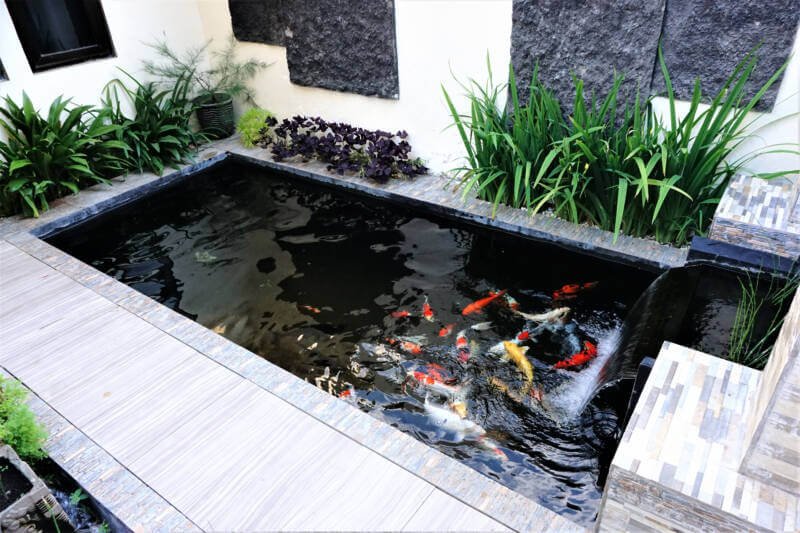
Some types of algae, such as green algae and string algae (also called filamentous algae), can be an important part of a pond ecosystem. These provide a source of food, energy, and oxygen.
An excessive amount of either type, however, can result in critically low levels of dissolved oxygen in the water, thereby harming or potentially killing your fish.
To facilitate algae control, consider adding the species listed below to your pond.

These algae-eating fish, tadpoles, and snails are effective bottom feeders that, along with routine maintenance, can help keep pond algae under control. The result: a healthy pond and happy fish!
In this article
1. Grass Carp
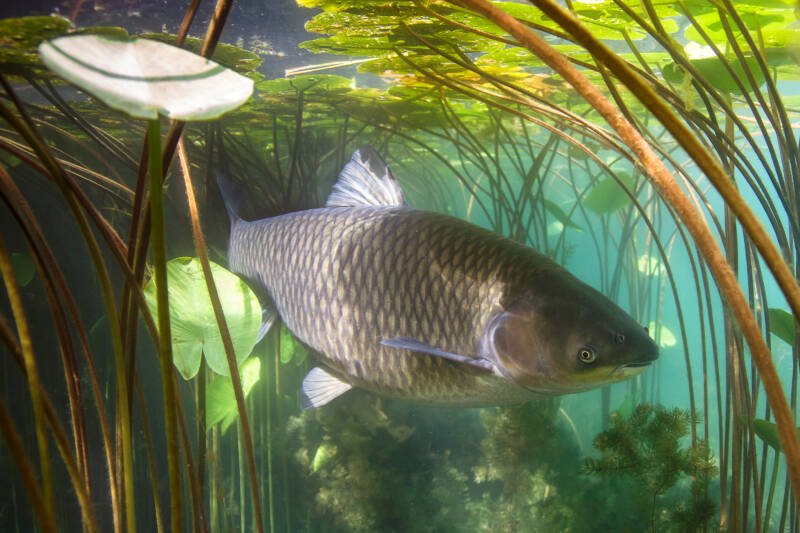
The grass carp is a large member of the minnow family native to the rivers of eastern Russia and southern China. It has a green/brown-colored body, silvery sides, and large scales outlined in dark brown or black, giving it a “fishnet” pattern.
You might purchase young fish at a length around 7.9 inches (20 cm), but they quickly grow to 3.9 feet (1.2 meters) and 40 pounds (18 kg) in weight in six months! As a result, they are best suited to large ponds.
These species feed from the top of the plant downward, resulting in clearer water because the sediment is not disturbed. They eat a variety of water plants and can consume up to three times their body weight each day!
The grass carps are hardy and tolerate a wide range of water conditions, including oxygen levels, low levels of salinity, and winter conditions.
State regulations regarding pond types and number of fish allowed vary, so contact your local Fish and Wildlife division for more information.
2. Pond Loach

The pond loach, also known as the dojo or weather loach (Misgurnus anguillicaudatus), hails from East Asia but has been introduced to many places around the world.
This fish grows to a maximum length of 12 inches (30.5 cm) and has a lifespan of seven to 10 years. This friendly fish does not need to be kept in a school and will get along with other species in your pond.
Long and eel-like in shape, these enthusiastic feeders scavenge the bottom of the pond, eating algae and organic material both day and night.
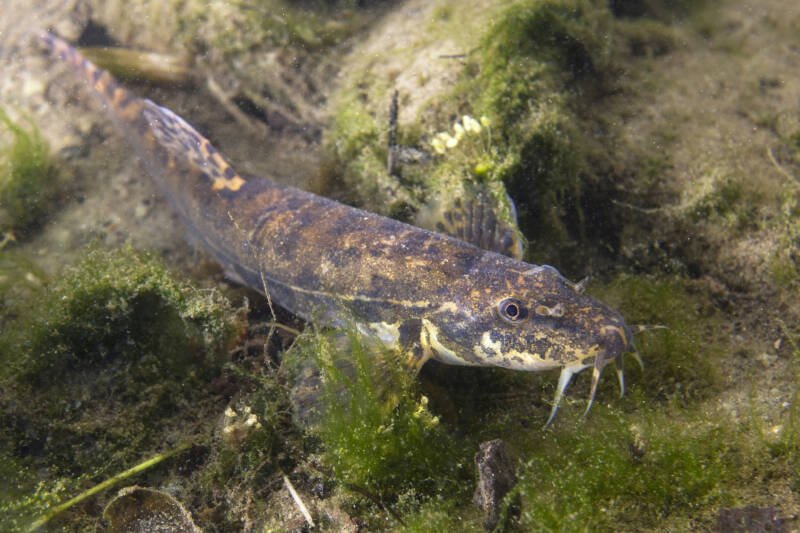
They are incredibly tolerant fish, capable of withstanding a temperature range from 40 to 77 degrees Fahrenheit (4.5 to 25 degrees C). This fish, along with the hillstream loach, is a great candidate for cold water ponds.
Interestingly, the pond loach can indicate a forthcoming change in the weather. As barometric pressure drops, your fish may swim erratically or even vertically.
3. Chinese High Fin Banded Shark
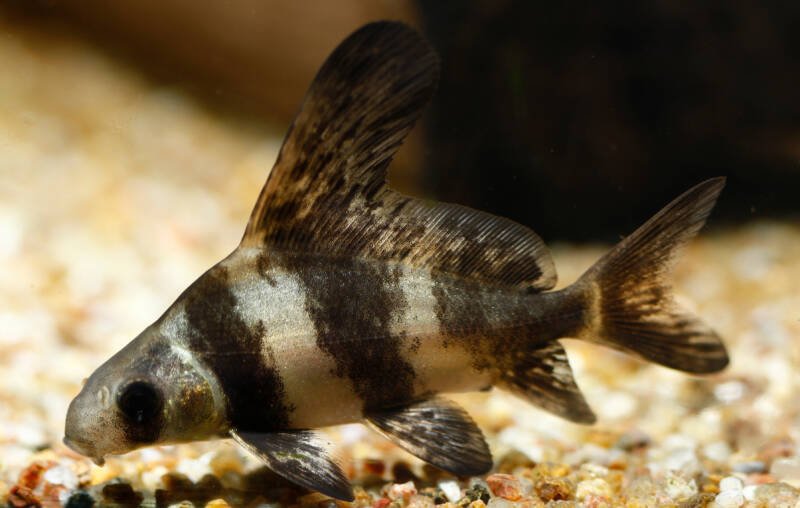
The Chinese high fin banded shark (Myxocyprinus asiaticus) is native to the Yangtze River.
They feature a banded, black and white body and a tall dorsal fin. With proper care, they can grow anywhere from three to four feet (0.9 to 1.2 meters) in length. This growth occurs slowly relative to other pond fish. Still, this fish is best for large ponds.
This easy-going algae eater will school, does well in small groups of three or more, and will not bother other species.
It is cold-water tolerant in a temperature range between 55- and 75-degrees Fahrenheit (13 to 24 degrees C). Install a heater for your pond if winter temperatures will drop the water temperature below the minimum range, and make sure your pond has plenty of hiding places.
4. Shubunkin Goldfish
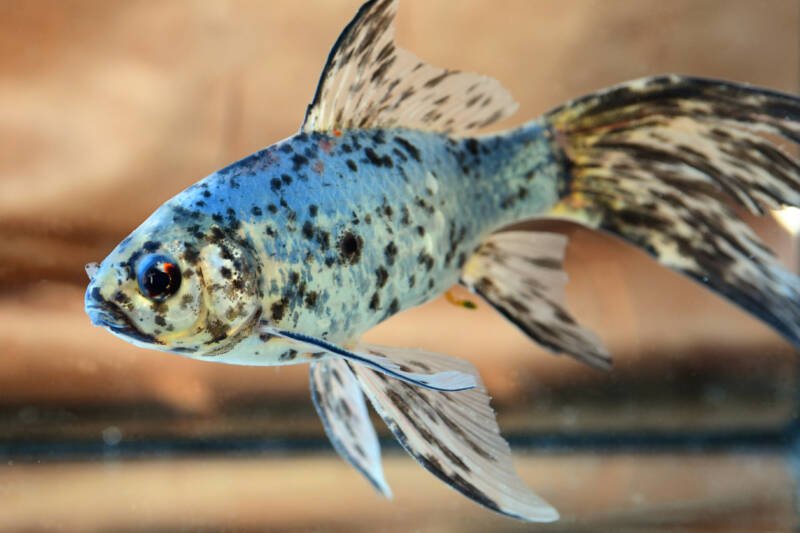
The Shubunkin goldfish has stunning coloration, resembling koi fish. They have a silvery body, splashes of orange, and random black spots.
There are three types of Shubunkin: American, London, and Bristol, with differences in their body and fin shapes. Their calico patterns come in many hues, with blue tint being the most prized.
They are quite social, fast swimmers, and voracious eaters that grow to a length of up to 12 inches (30.5 cm).
This fish tolerates cold water and thrives in both large indoor tanks and outdoor ponds.
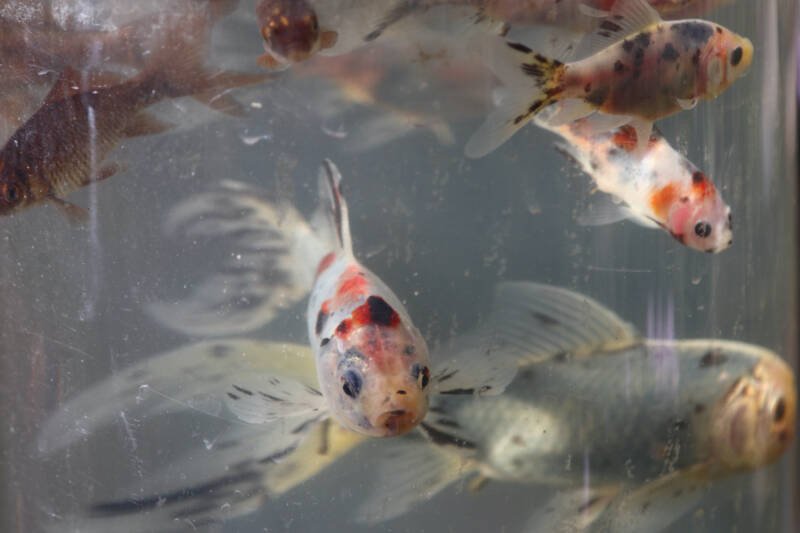
They can remain outdoors in the winter if the pond depth is two feet (0.6 m) or more. You might use a pond de-icer to prevent ice from forming completely on the surface to allow oxygen to the water.
5. Otocinclus
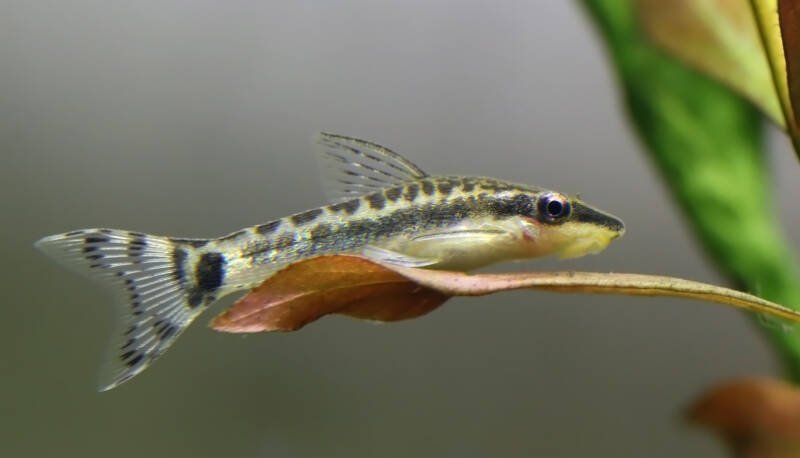
Otocinclus are small, but mighty, algae eaters that hail from the South American waters of Venezuela and Argentina.
There are many size variations, but most fish max out at a length of two inches (5 cm). They have an elongated, narrow body with a prominent horizontal stripe and a large sucker mouth.
These fish spend their time at the bottom of the pond and do well in protective groups.
Because of their size, they are best placed in small ponds with similarly-sized, peaceful fish. The otocinclus will keep to itself and not bother any other species.
Line your pond with a soft substrate and include some hiding spaces. They require slightly warmer water temperatures, so bring these little guys inside for the winter.
6. Bullfrog Tadpoles
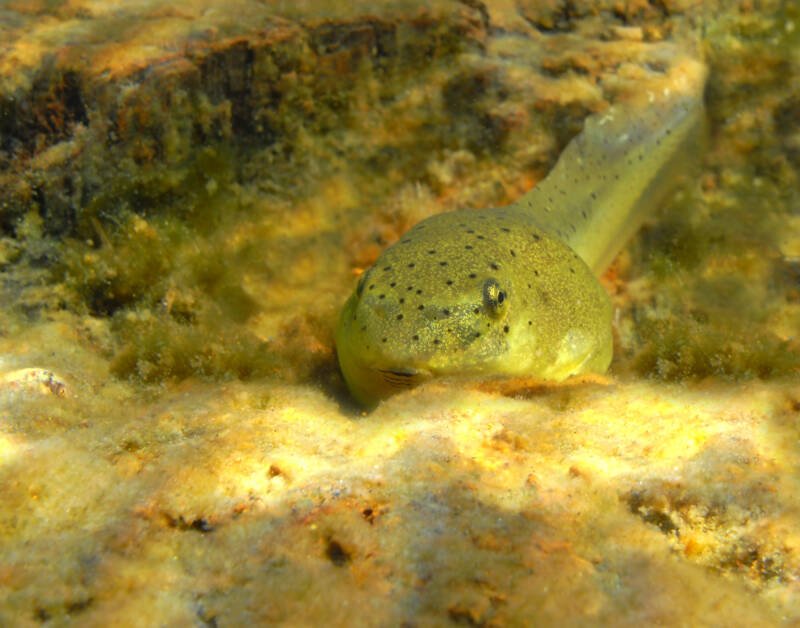
Bullfrogs are native to the midwestern, eastern, and southern sections of the United States, but have been introduced in many locations around the world.
Tadpole colors range from light to dark green, and they can have dark spots.
Tadpoles are a great addition to your outdoor pond because in this phase, they consume algae and plant matter in addition to mosquito larvae.
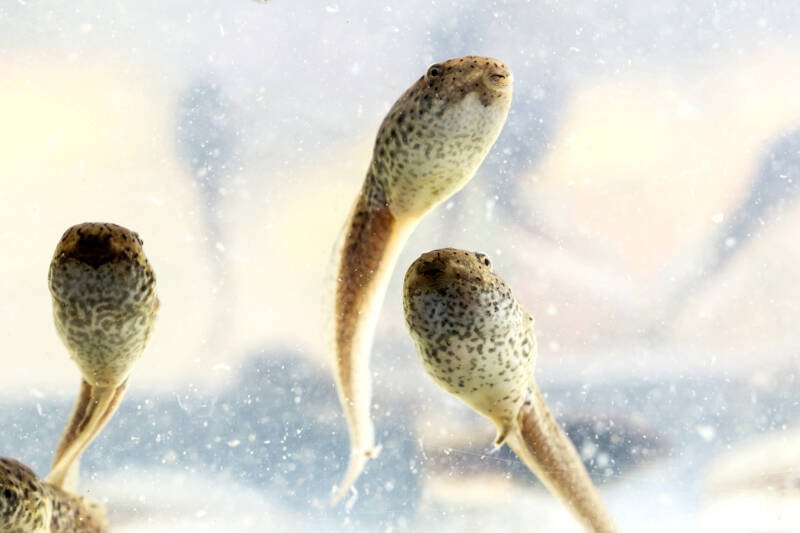
This species prefers shallow water that is warm and rich with aquatic plants.
7. Plecostomus
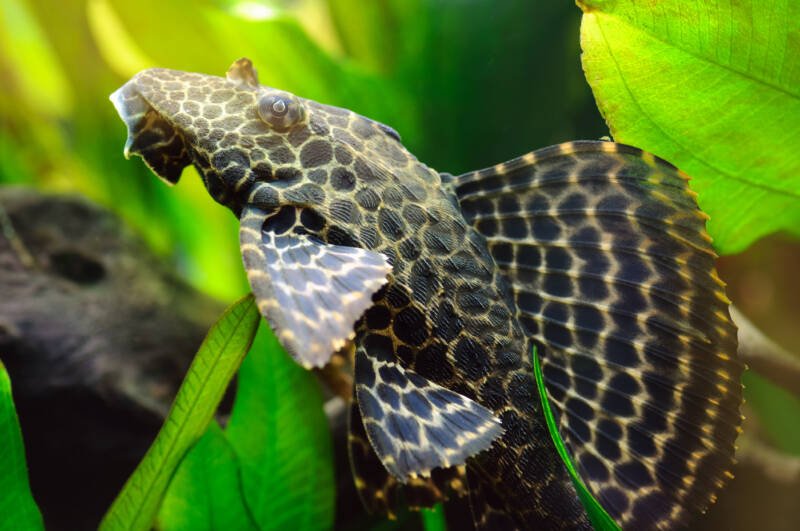
The name plecostromus (pleco or suckermouth catfish), is ascribed to several algae-eating species. These fish are efficient consumers, very hardy, and adaptable to their environment and food sources.
Plecos are warmer water fish. If you keep them in outdoor ponds, ensure that the water temperature does not drop below 50 degrees Fahrenheit (10 degrees C), or you risk losing your fish.
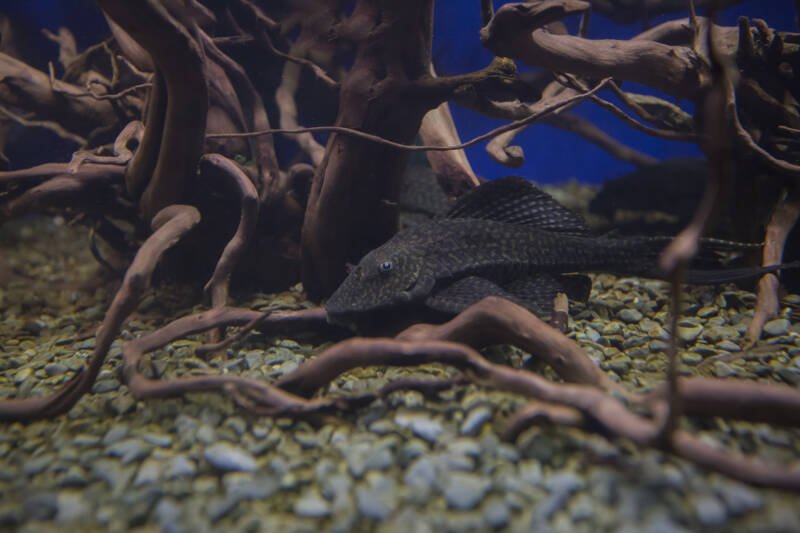
Different species grow to vastly different lengths as adults, so know the maximum size of the fish you select.
For example, larger species include common plecos (18 inches/46 cm), rhino plecos (11 inches/28 cm), and spotted plecos (24 inches/61 cm). These species are best for ponds or extremely large aquariums.
There are smaller plecos, such as the albino bristlenose pleco, which grows to an adult length of five inches (13 cm).
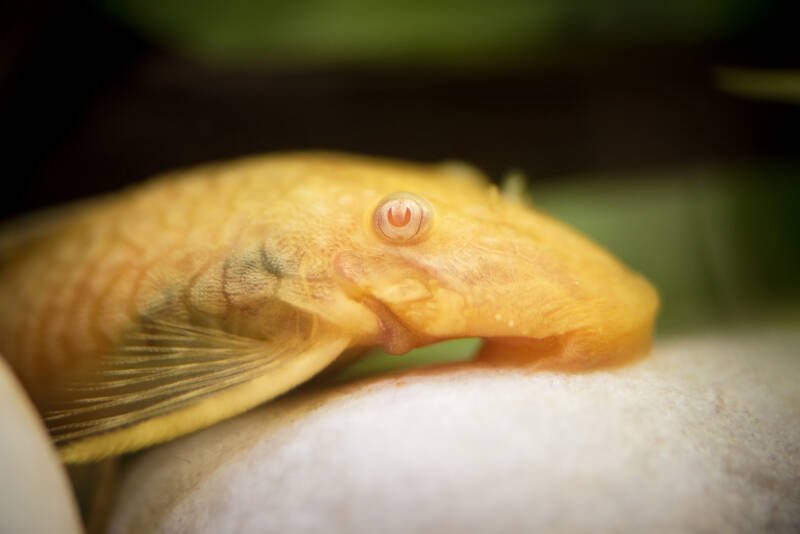
8. Koi

Koi (Cyprinus carpio) is a general name that covers several classes and subspecies of carp.
You may have seen orange, black, and white koi, but they also appear in combinations of yellow, red, or even blue. These popular pond inhabitants will eat both algae and insects.
Koi are hardy fish and can tolerate water temperatures ranging from 59 to 77 degrees Fahrenheit (15 to 25 degrees C).

Plan on keeping these fish in large ponds, as they grow to a length between one and three feet (0.3 to 0.9 m). The pond also should be over three feet (one meter) deep to allow for adequate swimming space.
Plan on some shade as well. Koi can be sunburned if left in a shallow pond in strong sunlight.
9. Goldfish

If you do not think of koi when you think “fish pond,” then you undoubtedly think of goldfish. We have already mentioned the shubunkin goldfish, but there are more than 30 other varieties.
These fish are hardy, readily available, and come in an array of body shapes, fin shapes, colors, and sizes.
Take care in choosing the right-sized goldfish for your pond. Some only grow to a few inches in length and may be considered food by other fish in the pond. Still others grow up to one foot (0.3 m) in length.
Goldfish will readily eat algae, but it is not their only nutritional need. Complete their diet with commercial or live foods.
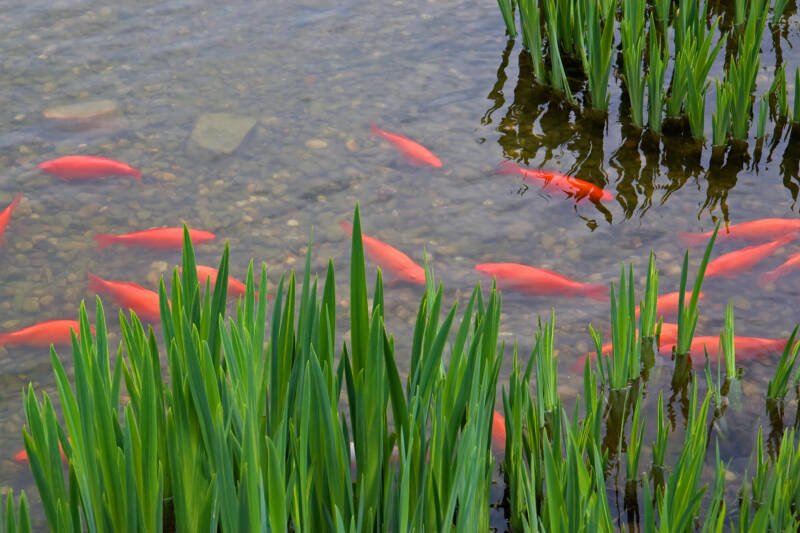
These tough fish can withstand a winter outdoors, provided you do not let the water temperature go below 40 degrees Fahrenheit (4.4 degrees C). For fancy goldfish, that bottom temperature is around 45 degrees (7 degrees C).
10. Siamese Algae Eaters

The Siamese algae eater (Crossocheilus oblongus) comes from the warm waters of Southeast Asia. These fish are long and slender, with a shiny grey or gold color and a thick, black stripe running horizontally from head to tail.
It is a smaller pond fish, growing to a maximum of six inches (15 cm) in length. This hardy algae eater is very active and fun to watch.
Line your pond with a sandy substrate and include plenty of rocks or other hiding spaces.
Because this fish is accustomed to warmer waters (70 to 79 degrees Fahrenheit or 21 to 26 degrees C), you will need to bring them indoors for the winter or if temperatures will be low for an extended period.
11. Black Mollies

The black molly (Poecilia sphenops) is selectively bred for dark coloration. Juvenile fish may have spots of gold or silver.
Although native to Central and South America, it can be found as an invasive species in Japan and Eastern Europe.
Due to breeding practices, this fish is slightly more susceptible to disease. Take care when purchasing your fish to ensure you choose a healthy one.
These fish grow to a maximum of three to five inches (8 to 12 cm) in length and are good for small ponds.
They prefer a heavily planted environment and will eat plant material, algae, detritus, and fresh or frozen foods.
Bring your mollies indoors for the winter, as they do best in temperatures over 75 degrees Fahrenheit (24 degrees C).
12. Japanese Trapdoor Snail
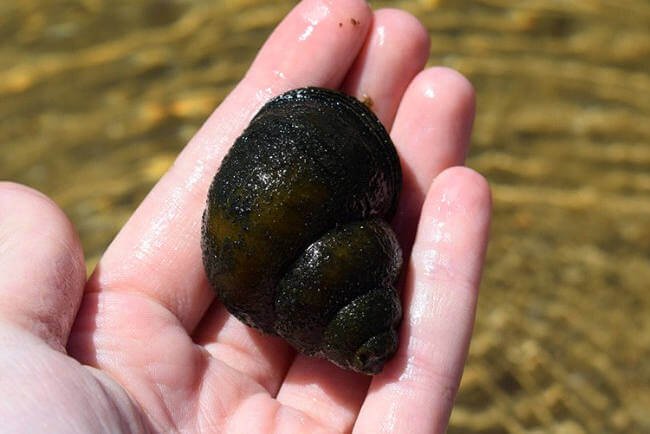
The Japanese trapdoor snail (Viviparis malleatus) is a tough, attractive, and low-maintenance freshwater species.
They have a variety of shell colors, from green to brown or black, and grow to an average size of two inches (5 cm).
This snail will readily consume decaying matter and waste on plants, decorations, rocks, and walls. This humble species is tough enough to winter outdoors, even in more northern locations.
It is considered invasive in some areas, so check with your local Fish and Wildlife division before adding them to your pond.
13. Mosquito Fish
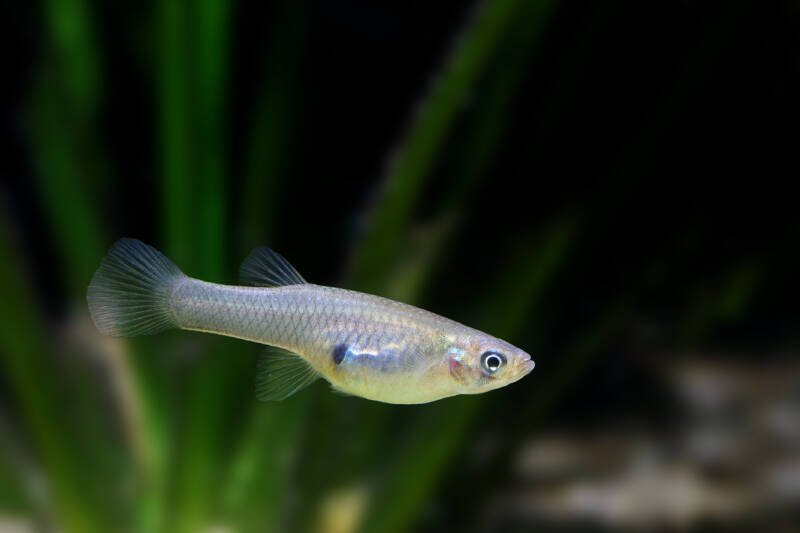
The mosquito fish (Gambusia affinis) is a small, but effective addition to your pond upkeep team.
Maxing out at three inches (7.6 cm) in length, this fish is an opportunistic omnivore, voraciously feasting on algae and mosquito larvae. In fact, grown mosquito fish can consume hundreds of larvae in a single day!
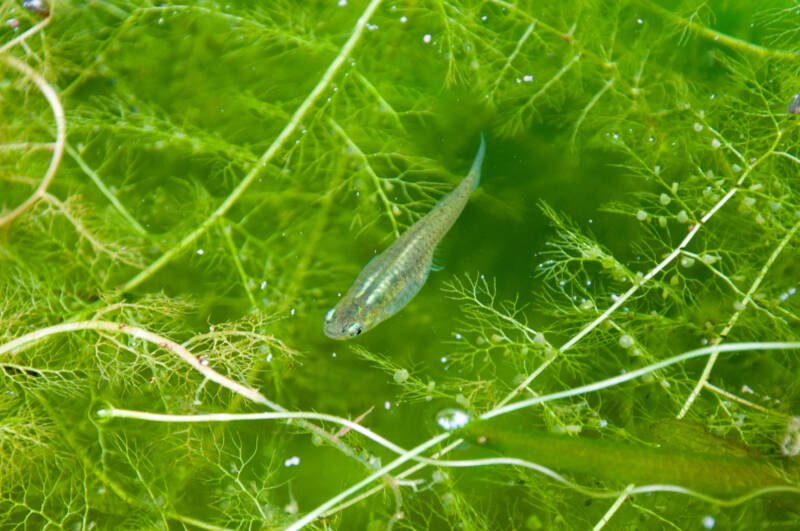
These fish are great companions for ornamental pond fish and will not harass them in any way.
Make sure there are plenty of hiding places so your mosquito fish can escape any environmental predators who may consider them food.
Mosquito fish can tolerate extreme temperatures in outdoor ponds, anywhere from near freezing to 100 degrees Fahrenheit (38 degrees C).
14. Apple Snail
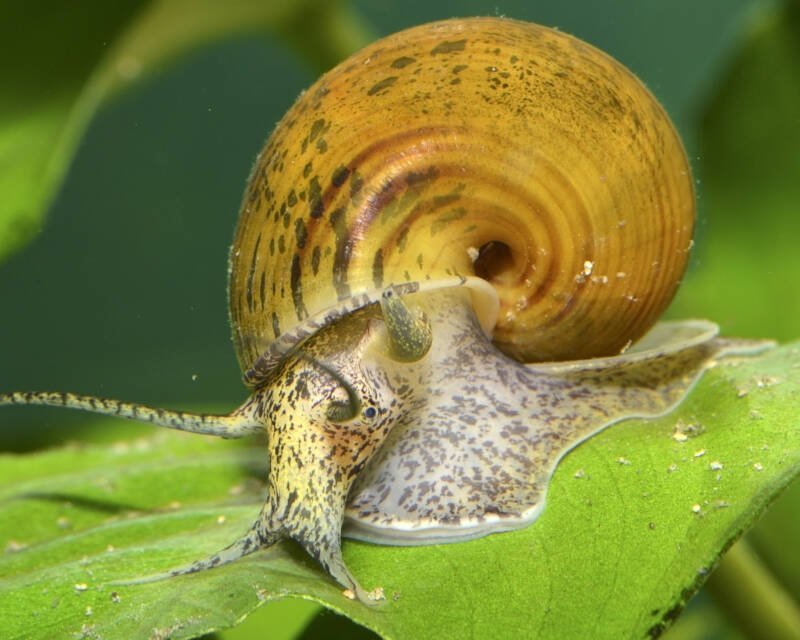
The apple snail (Ampullariidae) is a tropical freshwater snail native to South America. It has shell colors ranging from bright yellow to brown/blue and grows to a diameter of one inch (2.5 cm).
This species has a hefty appetite and devours organic matter, sometimes resulting in damage to pond plants.
Take care when keeping them with other small scavenging species as you may have to ensure that there is enough food for both.
These snails prefer a warmer water temperature range of 70 to 80 degrees Fahrenheit (21 to 27 degrees C). As such, they cannot stay outside in ponds where the temperature goes below 65 degrees Fahrenheit (18 degrees C).
They are considered invasive in some areas. It is always best to check with your local Fish and Wildlife before introducing this species to your pond.
Closing Thoughts
Choosing the right fish for your pond is important and selecting a species to help control algae growth just makes sense.
Consider the size of your pond, temperature tolerance of the fish, and their compatibility with other species when making your selection.
We welcome your feedback and would love to hear about your pond!
Which are your favorite fish to help control algae?